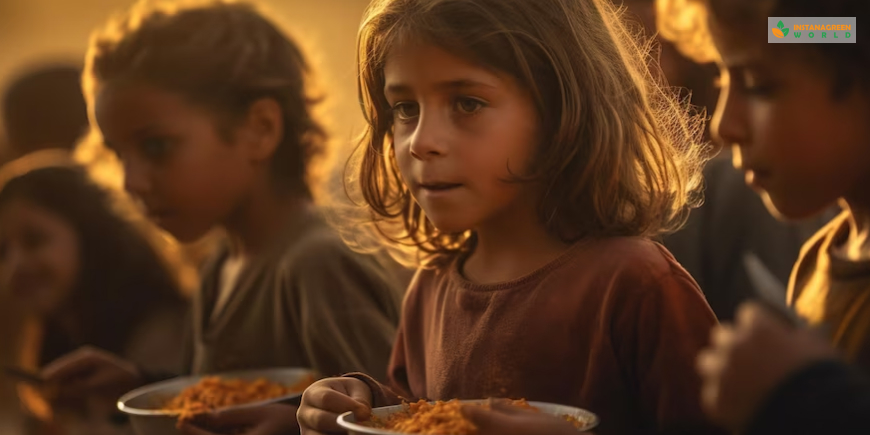The global food crisis is a complex and multifaceted challenge that involves a range of interconnected issues affecting food production, distribution, access, and sustainability.
The Big Picture Of The Global Food Crisis

The global food crisis requires a holistic and collaborative approach. It involves governments, international organizations, the private sector, and local communities.
Sustainable practices, technological innovations, policy reforms, and a focus on social and economic equity. They are essential components of building a more resilient and equitable global food system.
What Are The Causes Of The Global Food Crisis?

Here are some of the key factors contributing to the global food crisis:
Conflict
The food crisis in conflict zones requires a holistic approach. That considers immediate humanitarian needs and the underlying causes of conflict.
Efforts should focus on building resilience, restoring livelihoods, and fostering peace and stability. To create an environment conducive to sustainable food production and access.
Economic Shocks
Food crises often result in a spike in food prices due to decreased supply and increased demand. Or disruptions in distribution channels.
Countries heavily reliant on food imports may face trade imbalances and increased pressure on foreign exchange reserves.
Weather Extremes
Extreme weather events can contribute to food crises by disrupting agricultural systems. By reducing crop yields, and affecting food production and distribution.
Droughts lead to water shortages, impacting irrigation for crops. Without sufficient water, crops may wither, and yields decline.
Six Global Food Crisis Facts

- The total population is facing worse crisis of food insecurity see an increase of 35% by 2021. Affecting about 258 million people in 58 countries and territories.
- One in three people in the world is suffering from one or other level of malnutrition.
- The countries that are facing the highest number of food crisis insecurity. It include Ethiopia, the Democratic Republic of the Congo (DRC), Nigeria, Yemen, and Afghanistan.
- About 149 million children are stunned by the year 2020.
- After almost a decade of constant decline, the world hunger rate has been increasing in 2015. In 2010, the hunger population has not been that high.
Action Taken By The World Bank

Back in 2022, World Bank gave a commitment that they are availing $30 billion. A period of 15 months to tackle this food crisis. They have increased their food and nutrition security response by about $22 billion, making the total about $45 billion.
This food and nutrition security will span over 90 countries that will include long and short term projects. Like social protection and boosting productivity along with climate-smart agriculture.
The initiative taken by the food bank will benefit 335 million people. Which is equal to 44% of the total undernourished population. And about 53% of the total is women who are affected disproportionately by the food crisis.
World Bank Action
- “The $2.75 billion Food Systems Resilience Program for Easter and Southern Africa. It help countries in Esternn and Southern Africa increase the resiience of the region’s food systems. And the ability to tackle growing food insecurity. In phase three, the program will enhance inter-agency food crisis response boost medium & long term efforts for resilient agricultural production. Sustainable development of natural resources, expanded market access, and a greater focus on food systems resilience in policymaking.”
- “A $95 million credit from IDA for the Malawi Agriculture Commercialization Project to increase commercialization of agriculture value chain products. And to procide immediate and effective response to an eligible crisis or emergency.”
- “The $200 million IDA grant for Madagascar to strengthen decentralized service delivery, upgrade water supply, restore and protect landscapes. And strengthen the resilience of food and livelihood systems in the drought-phone Grand Sud.”
- “A $60 million credit for the Integrated Community Development Project that works with refugees and host communities in four northern provinces of Burundi to improve food and nutrition security. Build socio-economic infrastructure, and support micro-enterprise development through a participatory approach.”
- “The $15 million Guinea Bissau Emergency food Security Project, 329,000 smallholder farmers in Central Afica Republic have received seeds Farming tools and training in agricultural and post-harvest techniques to boost crop production and become more resilient to climate change.”
- “The $175 million Sahel Irrigation Initiative Regional Support Project is helping build resilience and boost productivity of agricultural and pastoral activities in Burkina Faso, Chad, Mali, Mauritania, Niger, and Senegal. 130,000 farmers and members of pastoral communities are benefiting from small and medium-sized irrigation initiatives.”
World Bank Action Taken
- “The $60 million Accelerating the Impact of CGIAR Research for Africa (AICCRA) project has reached nearly 3 mililon African farmers with critical climate smart agriculture tools and information services in partnership with the Consortium of International Agricultural Research Centers (CGIAR). These tools and services are helping farmers to increase production and build resilience in the face of climate crisis.”
- “The $766 million West Africa Food Systems Resilience Program is working to increase preparedness against food insecurity and improve the resilience of food systems in West Africa. The progrma is iincreasing digital advisory services for agriculture and food crisis prevention and management, boosting adaptation capacity of agriculture system actors, and investing in regional food market integration and trade to increase food security.”
- “A $150 million grant for the second phase of the Yemen Food Security Response and Resilience Project, which will help address food insecurity, strengthen resilience and project livelihoods.”
- “$50 million grant of additional financing for Tajikistan to mitigate food and nutrition insecurity impacts on households and enhance the resilience of the agriculture sector.”
- “$125 million project in Jordan aims to strengthen the development the agriculture sector by enhancing its climate resilience, increasing competitiveness and inclusion, and ensuring medium to long term food security.”
- “A $315 million loan to support Chad, Ghana and Sierra Leone to increase their preparedness against food insecurity and to improve the resilience of their food systems.”
- “A $300 million project in Bolivia that will contribute to increasing food security, market access and the adoption of climate-smart agricultural practices.”
Wrapping Up!
Well, there you go; the ongoing global food crisis is something that everyone needs to know. If you don’t have a much deeper understanding of the topic, this is the perfect blog article for you.
If you think that this article was quite helpful and informational for you, all you need to do is give this article a like and comment down below.
Read more...
Types Of Pollution: Its Causes, Effects And Solutions
Explained: What Causes Global Warming And Climate Change?
What Causes Acid Rain? How Can It Affect Your Health?














